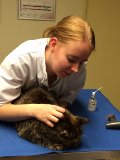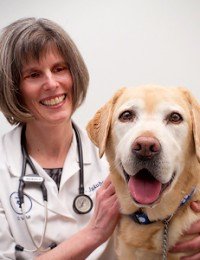Kim Campbell Thornton
Whether they live on faraway islands, in the Great White North, or in European capitals, cats and dogs benefit from Fear Free techniques. Three veterinarians share how Fear Free has helped pets in their far-flung practices.

Kim Campbell Thornton
Whether they live on faraway islands, in the Great White North, or in European capitals, cats and dogs benefit from Fear Free techniques. Three veterinarians share how Fear Free has helped pets in their far-flung practices.

It is amazing to me that making a few small changes really impacts patient comfort. We have started using fleece blankets and pheromones for the cats as well as giving treats to them and there is a noticeable difference in their behavior.
We are trying to really talk to new owners about doing handling exercises with their puppies and kittens and also trying to get them used to being in crates and carriers at a young age. The owners are also happy to learn that treats and training help them at home to perform ear cleaning, nail trims, and medicating without stressing their pets.
Sheryl Doi, DVM; Elite Fear Free Certified Professional; VCA Family and Oahu Veterinary Specialty Center; Pearl City, HI, United States

I have multiple success stories! Most dogs are rushing into our practice and don’t have to get pulled in by the owners; they’re pulling their owners in! It’s such a pleasure to watch clients be amazed by how happy their dog is to see us.
Cats are not small dogs, and they won’t rush into the room to see their veterinarian. But it’s also a pleasure to see cats changing from “aggressive” to calm and relaxed when using PVPs.
Jonna Hoekstra, DVM; Elite Fear Free Certified Professional; Sterkliniek dierenartsen; Amsterdam, The Netherlands

The following Fear Free techniques have worked very well with a number of my patients:Examining a cat that is normally fearful in clinic by putting her into a “cats only” exam room outfitted with a towel on which to lie that’s been sprayed with Feliway; having a Feliway dispenser in the wall outlet); going very slowly and quietly; doing my exam in whatever order makes sense given the cat’s demeanor/position; starting by gently rubbing forehead or chin; monitoring response; putting out some food to give the cat a pleasant distraction during vaccination.
Iz Jakubowski, DVM; Elite Fear Free Certified Professional; Royal York Animal Hospital; Etobicoke, Ontario, Canada
Want to be featured? Submit your success story here!
This article was reviewed/edited by board-certified veterinary behaviorist Dr. Kenneth Martin and/or veterinary technician specialist in behavior Debbie Martin, LVT.
Action Required! Your Membership has expired
Renew yourself by clicking Renew on My Homepage
Team Members, please tell your Team Admin
Students, apply here to renew your membership
Why?
Renewing and keeping an active membership is one of the requirements to maintaining your certification as well as access to member benefits.
Need help? Please contact our Customer Experience team at wags@fearfreepets.com or call us at 303.952.0585 and we will be happy to assist!
Go to My Homepage
Action Required: You Were Removed from Your Fear Free Team
Update account information by clicking here to go to your account info.
Please note: If you were recently removed from your Fear Free team, your membership will either expire 90 days from the removal date or expire at your current membership renewal date, whichever comes first. Already renewed? Update your account information through the link above. You will continue to receive this notice until your company information has been updated.
Need to join a different Fear Free team or have questions?
Please contact our Customer Experience team at wags@fearfreepets.com or call us at 303.952.0585 and we will be happy to assist!
Go to My Homepage